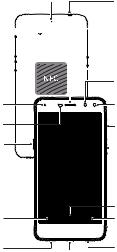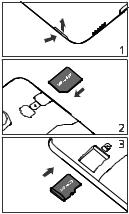Huawei MYA L11 Manual

Quick Start Guide
For more information
Go to http://consumer.huawei.com/en/ to download the user guide for your device (including safety information) and read the FAQ, privacy policy, and other information.
Go to Settings > About phone > Legal information to read the legal information.
For more information on regulation, touch Settings >
About phone > Authentication info.
Please visit http://consumer.huawei.com/en/support/ hotline/ for the most up-to-date contact information for your country or region.
 All pictures and illustrations in this guide, including but not limited to the phone color, size, and display content, are for your reference only. The actual product may vary. Nothing in this guide constitutes a warranty of any kind, express or implied.
All pictures and illustrations in this guide, including but not limited to the phone color, size, and display content, are for your reference only. The actual product may vary. Nothing in this guide constitutes a warranty of any kind, express or implied.
1

Your phone at a glance
Before you start, let's take a look at your new phone. Press and hold the power button to turn your phone on or off.
 To forcibly restart your phone, press and hold the power button until your phone vibrates.
To forcibly restart your phone, press and hold the power button until your phone vibrates.
Noise |
Headset jack |
reduction |
|
microphone |
|
Flash 


 Camera
Camera
|
Earpiece |
|
|
Front |
|
|
camera |
|
Status |
Front Flash |
|
indicator |
|
|
Light |
Volume |
|
sensor |
||
button |
||
Easy Key |
||
Power |
||
|
||
|
button |
|
Home |
Return |
Recent |
Speaker |
Microphone |
|
Micro USB port |
 Please keep the NFC area close to other devices or objects while using the NFC function.
Please keep the NFC area close to other devices or objects while using the NFC function.
2

Getting started
Follow the instructions in the following figures to set up your phone. Do not insert or remove a SIM card while your phone is on.
3
Safety information
This section contains important information about the operation of your device. It also contains information about how to use the device safely. Read this information carefully before using your device.
Electronic device
Do not use your device if using the device is prohibited. Do not use the device if doing so causes danger or interference with other electronic devices.
Interference with medical equipment
•Follow rules and regulations set forth by hospitals and health care facilities. Do not use your device where prohibited.
•Some wireless devices may affect the performance of hearing aids or pacemakers. Consult your service provider for more information.
•Pacemaker manufacturers recommend that a minimum distance of 15 cm be maintained between a device and a pacemaker to prevent potential interference with the pacemaker. If using a pacemaker, hold the device on the side opposite the pacemaker and do not carry the device in your front pocket.
Protecting your hearing when using a headset
•Using a headset at high volumes may damage your hearing. To reduce this risk, lower the headset volume to a safe and comfortable level.
4
•Exposure to high volumes while driving may cause distraction and increase your risk of an accident.
Areas with flammables and explosives
•Do not use the device where flammables or explosives are stored (in a gas station, oil depot, or chemical plant, for example). Using your device in these environments increases the risk of explosion or fire. In addition, follow the instructions indicated in text or symbols.
•Do not store or transport the device in containers with flammable liquids, gases, or explosives.
Traffic security
•Observe local laws and regulations while using the device. To reduce the risk of accidents, do not use your wireless device while driving.
•Concentrate on driving. Your first responsibility is to drive safely.
•Do not hold the device while driving. Use hands-free accessories.
•When you must make or answer a call, pull off the road safely and park the vehicle first.
•RF signals may affect the electronic systems of motor vehicles. For more information, consult the vehicle manufacturer.
•Do not place the device over the air bag or in the air bag deployment area in a motor vehicle. Doing so may hurt you because of the strong force when the air bag inflates.
5
•Wireless devices may interfere with the airplane's flight system. Do not use your device where wireless devices are not allowed according to the airplane company's regulations.
Operating environment
•Avoid dusty, damp, or dirty environments. Avoid magnetic fields. Using the device in these environments may result in circuit malfunctions.
•Do not use your device during thunderstorms to protect your device against any danger caused by lightning.
•Ideal operating temperatures are 0 °C to 35 °C. Ideal storage temperatures are -20 °C to +45 °C. Extreme heat or cold may damage your device or accessories.
•Do not expose your device to direct sunlight (such as on a car dashboard) for prolonged periods.
•To protect your device or accessories from fire or electrical shock hazards, avoid rain and moisture.
•Keep the device away from sources of heat and fire, such as a heater, microwave oven, stove, water heater, radiator, or candle.
•Do not place sharp metal objects, such as pins, near the earpiece or speaker. The earpiece may attract these objects and result in injury.
•Stop using your device or applications for a while if the device is overheated. If skin is exposed to an overheated device for an extended period, low
6
